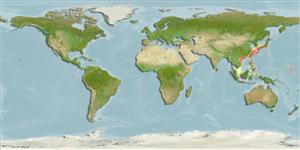Environment: milieu / climate zone / depth range / distribution range
Ökologie
seewasser riff-verbunden; standorttreu; tiefenbereich 15 - 100 m (Ref. 9710). Tropical
Western Pacific: southern Japan to Taiwan and northern Philippines.
Size / Gewicht / Alter
Maturity: Lm ? range ? - ? cm
Max length : 21.0 cm TL Männchen/unbestimmt; (Ref. 4858)
Rückenflossenstacheln (insgesamt): 15; Rückenflossenweichstrahlen (insgesamt): 15-16; Afterflossenstacheln 3; Afterflossenweichstrahlen: 17.
Inhabits seaward rocky and coral reefs (Ref. 9710). Hardy aquarium species; takes standard food such as chopped beef, freeze-dried shrimp, mysids, etc. A protogynous hermaphrodite (Ref. 55367). Forms permanent harem groups composed of a single male and several smaller females (Ref. 55367).
Life cycle and mating behavior
Geschlechtsreife | Fortpflanzung | Ablaichen | Eier | Fecundity | Larven
A monandric species (Ref. 55367). Sex change occurs at 9.3 cm TL (Ref. 55367). Forms permanent harem groups composed of a single male and several smaller females (Ref. 55367). Also Ref. 103751.
Allen, G.R., 1985. Butterfly and angelfishes of the world. Vol. 2. 3rd edit. in English. Mergus Publishers, Melle, Germany. (Ref. 4858)
IUCN Rote Liste Status (Ref. 130435)
Bedrohung für Menschen
Harmless
Nutzung durch Menschen
Aquarium: Kommerziell
Mehr Information
ReferenzenAquakulturAquakultur ProfilZuchtlinienGenetikElectrophoresesVererbbarkeitKrankheitenVerarbeitungNutrientsMass conversion
PartnerBilderStamps, Coins Misc.LauteCiguateraGeschwindigkeitSchwimmstilKiemenoberflächeOtolithsGehirngrößeSehfähigkeit
Tools
Zusatzinformationen
Download XML
Internet Quellen
Estimates based on models
Preferred temperature (Ref.
123201): 21.9 - 27.7, mean 24.3 °C (based on 24 cells).
Phylogenetic diversity index (Ref.
82804): PD
50 = 0.5010 [Uniqueness, from 0.5 = low to 2.0 = high].
Bayesian length-weight: a=0.03090 (0.01359 - 0.07026), b=2.89 (2.70 - 3.08), in cm total length, based on LWR estimates for this (Sub)family-body shape (Ref.
93245).
Trophic level (Ref.
69278): 3.4 ±0.45 se; based on food items.
Widerstandsfähigkeit (Ref.
120179): mittel, Verdopplung der Population dauert 1,4 - 4,4 Jahre. (Preliminary K or Fecundity.).
Fishing Vulnerability (Ref.
59153): Low vulnerability (11 of 100).
